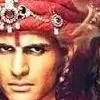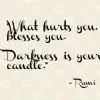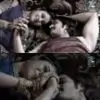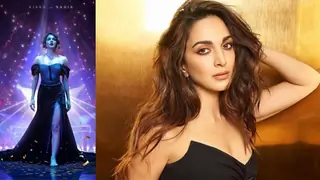Folks,
Of course the first and most important thing is to wish you all, and your families, a happy, healthy, peaceful and fulfilling 2017!
Next, I see that the last time I did a post, albeit only a mini one, was 2 weeks ago, but it feels like forever! This probably shows how much I am attached to all of you, my gentle readers, so much so that I have withdrawal symptoms when I am away from the forum and from you for a while. But these days, it is my RA which prevails, and I had a very bad flare up these 2 last weeks.
It seems to be receding a bit, so I am going to give this post my best shot while this lasts. But the time is already past 11 pm - it is only now that our guests have retired - so I do not think I will be able to finish it tonight. This will be Part 1, and the rest will follow tomorrow as Part 2.
The title is an indication of how I feel about Chandra Nandini this last week, which was Week 12. After the script yo-yoing for several weeks between surprisingly well written scenes and characters, and the abysmal versions thereof, often both in the same episode, I was driven to name my last full post Theatre of the absurd. Week 11 was only a slight improvement, for though it had some excellent scenes that gladdened my heart, they were bogged down in a sea of often crass melodrama, centred for the most part on Malayaketu's villainy and Chandragupta's strange credulousness in swallowing his pretensions, echoed even more strangely by Chanakya. It was only with this last week that the light of dawnbreak has begun to spread over the script, the actors, and the show as a whole.
Before I begin with the standout scenes, that too in reverse order, starting with Episode 60, I wanted to share with you some positives about Chandra Nandini that occurred to me, ranging from the trivial to the substantive. It is an indicative list, and you folks might like to think of some more positives to add to it.
-The latest montage is very nice, with the classic pose beloved of royal portraiture:the graceful, bright-eyed queen in the front, a very slight smile quivering on her lips, and the remote, cool king just behind her, eyes level and unreadable, mouth firm and unyielding, the whole pose that of one totally in control. We are free at last of the nari shakti and nayi soch affliction of a solo Nandini montage of the chimerical warrior princess.😉
-The title chant. Blessedly, this does not exist. After months and months of enduring Jodhaaa Akkkbar!, or Ashoka hai, Ashoka hai!, it is a real relief to have a silent montage!😉
- It is Chandragupta who gives the bhashans - like the one about the need for the king to retain a sense of balance, and be ready to apologise to anyone he has wronged - and not, as is the SOP in an Ekta serial, the mahaan heroine. Nandini has not as yet branched out into this area, and I hope she never does. Chandra would tackle any such bhashans as might be forthcoming much better, and the hero will, for once, get some brownie points and a thin coat of gilt on his persona!😉
-Till now, the equation between Chandragupta and Nandini is not tilted heavily in her favour, nor has any attempt been made as yet to show her as determinedly flawless, and as a preceptor to Chandragupta in assorted matters within and without her ken.
In fact, it is he who dominates most of the time, most recently as the strict Mauryan Henry Higgins to her Eliza Doolittle (both of My Fair Lady fame). He admires her courage and her intelligence, pushes her to use the latter and come thru the very tough exam of the Takshashila gurukul, and lauds her as a sampoorna stree, but this is without any of the sense of subordination of the hero that was so characteristic of the Jalal-Jodha equation, with its perennial Jodha Begum kabhi galat nahin ho saktin mantra.
Instead, Chandra often teases Nandini with relish, as after the daasi auction, and she is left without any comeback. And his handling of her fits and starts, many like those of a nervous filly, at the Baalgram Ashram (apparently a branch of the Takshashila gurukul that is much closer to Pataliputra), is masterly and a delight to behold!
-Rajat has, in this role, a far greater range of emotions and expressions to explore than he had in the only other outing in which I have seen him, as Jalal. The comic segments abound, and he attacks them with lip smacking relish; the Henry Higgins track is a superb example of this. But even a snippet, like the one where he expatiates on the indispensability of daasis for a royal establishment, is rendered side-splitting by the mischief that bubbles in his eyes as he comes out with sabse mahatvapoorna, snaan kaun karayega? 😉
-After a long spell of mediocre showings which made one despair of her touted acting prowess, Shweta's Nandini has begun to show distinct improvement. I am not yet ready to give her high marks - she fell down in that seminal scene in Episode 58 that I shall be taking up here, and her tic of biting her lower lip and widening her eyes under any and all circumstances continues - but she is getting to be far better than earlier, and one can now breathe a little easier.
Saanjha snaan (Episode 60): OK, that is enough of my list. Let us get on with the standout scenes, beginning with, what else, the absolutely delightful, 05:43 minute segment of Chandra and Nandini trying to bathe in the same enclosure while strictly preserving the proprieties, which had me, and you too, I am sure, rolling in the aisles.🤣
It was like a slomo version of a Charlie Chaplin classic silent movie segment. Beginning with the moment when Chandra trundles the shell-shocked but helpless Nandini into the bathing shed meant for two, to the closing shot of the two of them fixing their false beards and moustaches, it was one long round of pure comedy, all the more effective for being wordless.
There is Chandra's monastic effort to keep his word and not look back at Nandini in her deshabille, no matter how she drags her feet on the cold water snaan, or what sort of mess she creates with sandalwood paste or whatever it is that she drops.
This reaches its comic apogee when she slips and lands, as usual, on top of him, and he, catching an unintended glimpse of her undies, is shocked into promptly and tightly closing his eyes, and refusing to open them till she has taken herself off. 😆This was such an unexpected inversion of the genders in this kind of scene that I was in stitches!
The way in which Nandini periodically reaches out backwards and prods Chandra's midriff to attract his attention. The way in which she nods obediently after he has dunked her in cold water, and then proceeds to do what she could not get herself to do till then, take a really cold bath!
I am not going into what must have had 90% of the female viewers in ecstasy: the thoroughgoing display of the results of Rajat's very serious gymming over several months. It has clearly been very effective, and as for me, I was pleased to see, with his bedsheet dupatta now reduced to manageable proportions and leaving both shoulders free, that he looks extremely trim and sleek.
Finally, the look of total relief on both their faces when they have got thru the ordeal in good shape, with Chandra looking the more relieved of the two! 😉
All in all, a peach of a scene, conceived, directed and enacted to perfection.
I will pass over the rest of the episode, noting only that Nandini's ability to shut out the raging confusion stirred in her mind by Vakranaas' instructions that she should lead Chandra to his death, and to focus on the exam, and that too so successfully, was admirable. And that Chandra's barely suppressed pride in her excellent performance was delightful. It was odd, however, that he left her to her own devices after the exam ended, but for which she would never have ended up in the smashaan imbroglio.
A split level tour de force (Episode 58): This was an almost schizophrenic episode, with the two segments so sharply different in tone and mood that one did not know what to make of the lack of logic and consistency. But the quality of both the segments was outstanding, to phir aur kya chahiye? And the two lead actors played off each other exceedingly well. If, by the end, Chandra seemed to have won out, after all Rajat is a master of nuance, and the director highlights this with endless close ups of his micrometer changes of expression.
There is the initial awkwardness, the hesitant sidling up to a deliberately standoffish Nandini, the desperation in his face when she marches off with her books and he is left facing a dead end. The way in which he finally screws his courage to the sticking point (with apologies to Macbeth!) and, like a rider taking a high fence in a rush, launches abruptly into an apology. The way in which his awkwardness wears off as he begins to speak about the imperatives of rajadharma under such circumstances.
Nandini does well here, but her response shots are just about adequate. Still, she gives Chandra a way out by saying that in his place, she would have done the same thing.
Now comes the real McCoy, the fully 3 minute segment that just blew me away.
The deliberate, elegiac repetition of Yadi mein Chandra na hota, yadi tum Nandini na hoti, which seems at times too repetitive to begin with, acquires, by the end of the scene, the force and resonance of a tolling temple bell. And Rajat's Chandra reinforces this impact by delivering the exquisite lines levelly, eyes looking almost impersonal, the gaze not so much penetrating or probing as matter of fact for the most part, but at the very end, with a hidden regret in them that looks almost like longing.
Yadi ab hum is sansaar mein nahin hote..Yadi hamari paristithi kuch aur hoti..Yadi hamari kahani, hamari katha, kuch aur hote..Yadi main Chandra na hota, yadi tum Nandini na hoti..
Then the solemn, frank listing of all that divides them, the spilt blood that lies between them.. Yadi mein yeh purush na hota, yadi tum yeh stree na hoti... his eyes half closed, the gaze level but trying to make a connection with her thoughts...Tab kadachit hamari kahani kuch aur hi hoti..
Then comes the core of what he is seeking to convey to her: Kyonki, Nandini, tum mein wo saare gun hain jo ek sampoorna stree mein hone chahiye..This too as a matter of fact statement, made as much to himself as to her. The recounting of all which he had admired and still admires in her, her loyalty to her loved ones, her courage on the battlefield and off it... Yeh sab ek achche raja ke gun hain..
He reverts to the insurmountable barrier of their shared quest for revenge that will keep them apart forever. The unvoiced regret at this seeps thru the lines: Yadi hamare bhagya mein ek doosre ke liye pratishodh na hota, to avashya - note the shift to this from the earlier kadachit - hamara prarabdha kuch aur hi hota.
Then the almost bitter refrain: Parantu ab in baaton ka koyi arth nahin hai, kyonki main Chandra hoon aur tum Nandini ho..Shayad is jeevankaal mein sambhav nahin hai..Satya yahi hai ki hum donon ek doosre ke shatru hain, the, aur rahenge..Satya yahi hai ki hamare bhagya ko koyi nahin badal sakta..
Chandra is marvellous in the whole of this very demanding segment, never allowing the tone of his speech to waver and tip over into OTT posturing, and letting the unspoken regret, the almost sad sense of what might have been, seep thru into the viewer's mind without any overt stress or emphasis.
Nandini is not able to match him at all in this segment, which is a great pity. There is hardly any nuanced reaction in her face and her eyes, neither while he is speaking nor when she is thinking back about his words later.
The Henry Higgins avatar: The sudden , 180 degrees change of tone from the above to what follows immediately afterwards - for Chandra is in the same costume, so it has to be on the same day- is startling, and is left unexplained. However, as the latter half of the episode is as superb as the first, one hardly cares!
The sly look of self-satisfaction in Chandra's eyes as he leaves Nandini's room, after having planted the idea of going to the Baalgram ashram in male disguise to take the exam, is delightful.
The swar change operation would have thrown an ENT specialist into a fit😉, but the smile of pure pleasure on Chandra's face, as he watches Nandini's reaction to her new voice, is reflected in her eyes.
Equally delightful is Chandra's tutoring her on the haav bhaav, bartaav, chaal, chalan, dheel dhaal and the other traits of the male of the species, and on how she has to absorb these traits so thoroughly as to pass off convincingly as a man. If Nandini's initial exaggeratedly swaying gait - which is hardly the way she walks normally! - is played for laughs, Chandra's admonitions to her as she learns to walk like a man: Bhaybheet kyon ho?Haath seedhe, seena baahar, kandhe chaudhe, chehre par tej! , and the way in which he launches her on the path like a battleship, are so funny that one is in tears of laughter.😆
Finally, as she masters the male gait, and Chandra, arms crossed proudly, approves: Ab tum chali ek purush ki bhanti! , I was irresistibly reminded of an exhausted Eliza Doolittle finally mastering The rain in Spain falls mainly on the plain!
And as Nandini's stance, arms crossed exactly like her mentor's, mirrored Chandra's own, their new found camaraderie lit up the screen.
OK, folks, this is it for Part 1. My hand is screaming blue murder, and I am too tired to read this thru and correct any mistakes. Or to send the PMs. Just go thru it, would you, and I will be back tomorrow to finish Part 2, and clean up any spelling or syntax slips in this one?
Kal phir milte hain. Please do not forget to hit the Like button if you think that is warranted.
Shyamala/Aunty/Akka/Di







































